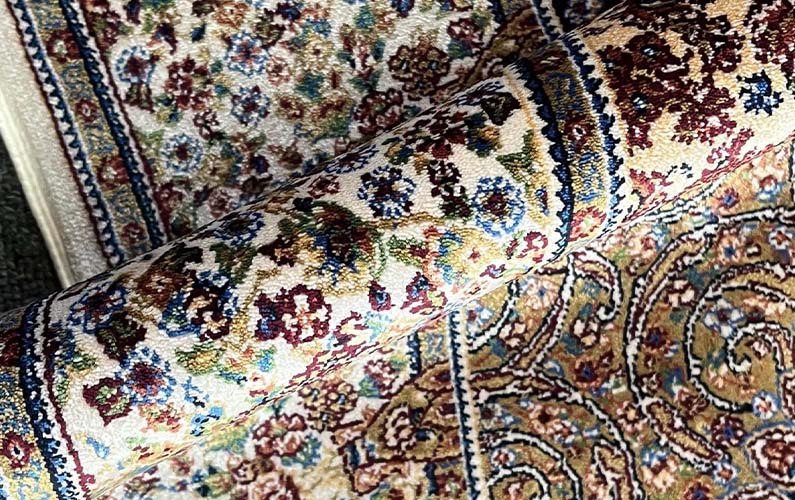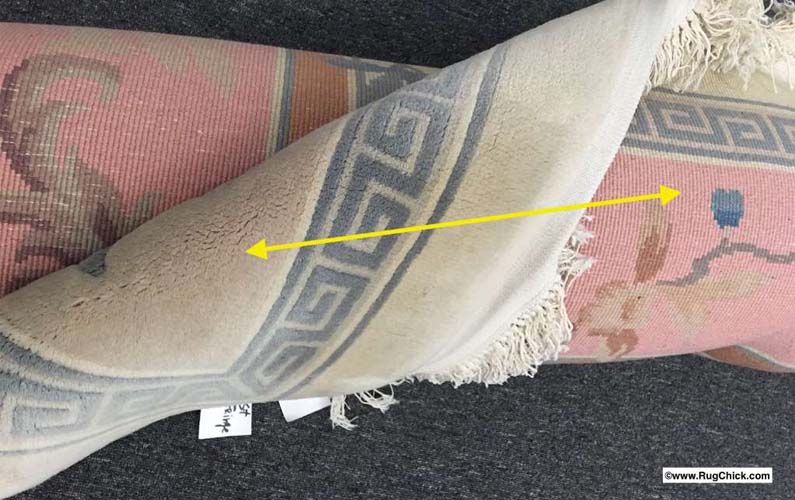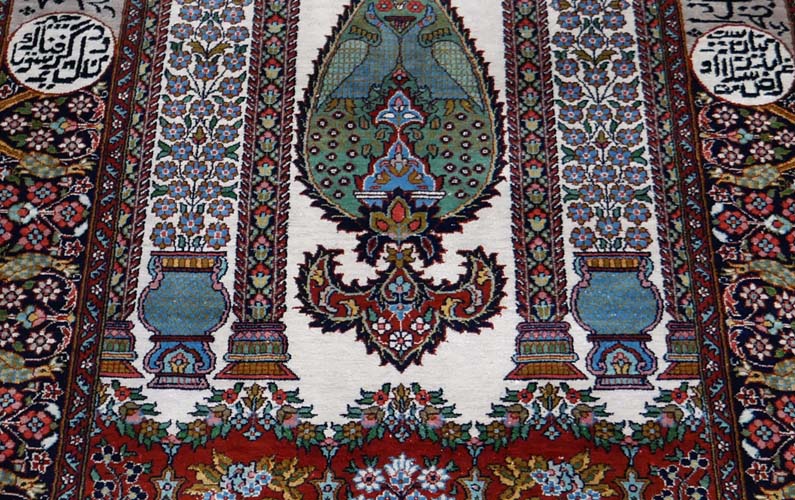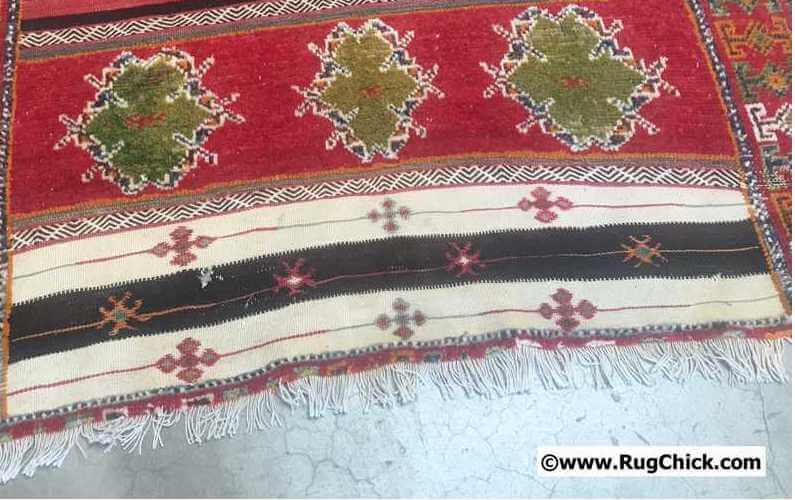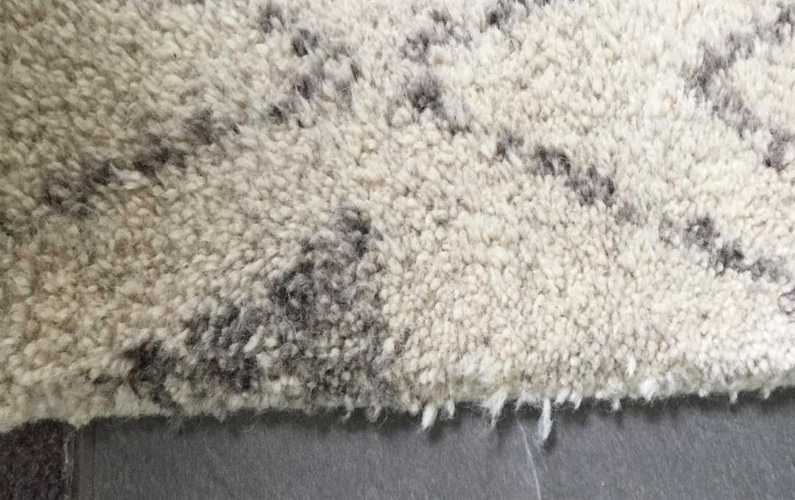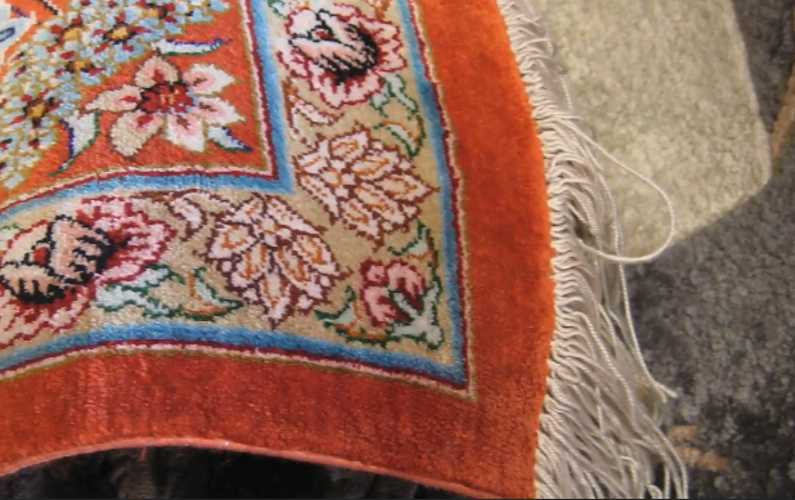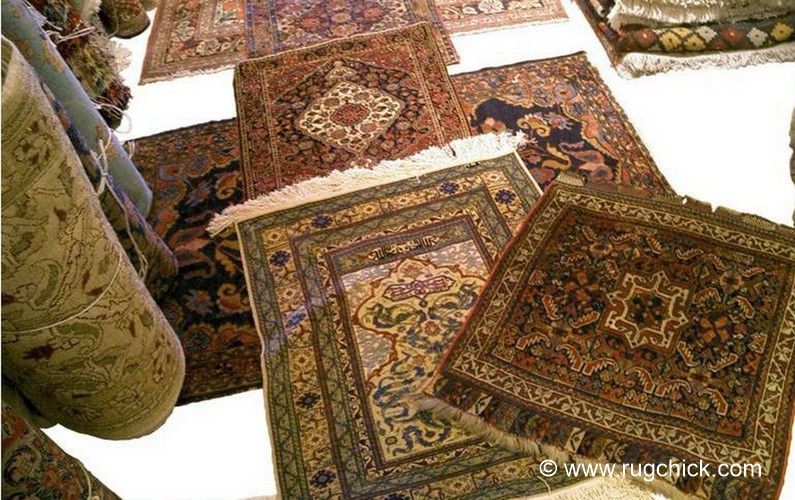Pet Accidents On Rugs. What To Do.
You might be traveling, and the anxiety of your absence with a house sitter in charge might lead to some accidents.
A puppy in training, or your older pets, might lead to accidents now and then.
Storms, fireworks, illness, excitement with visitors – accidents happen.
With an inexpensive tufted rug, this can be a blessing because it is protecting a much more valuable wood floor underneath it.
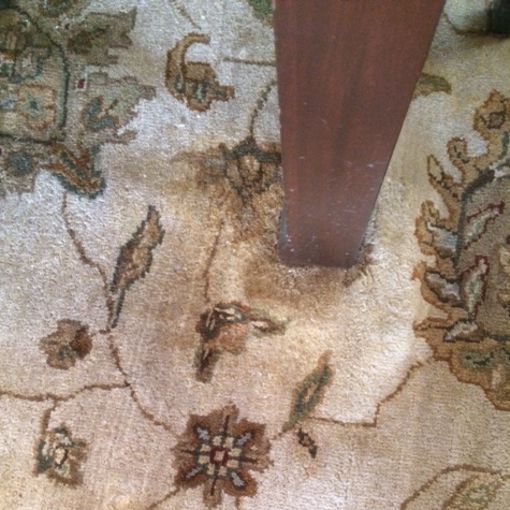
This wool India rug has heavy urine damage around the furniture leg. This rug had a pad which helped protect the floor from damage, and pads can be easily replaced.
With an oriental rug (hand woven), accidents can be costly because pet urine on a rug is one of the most dangerous spills on a textile – not only for the rug itself, but for the occupants if the accidents happen over and over creating fungal (mildew) and bacterial contamination in the middle of that rug.
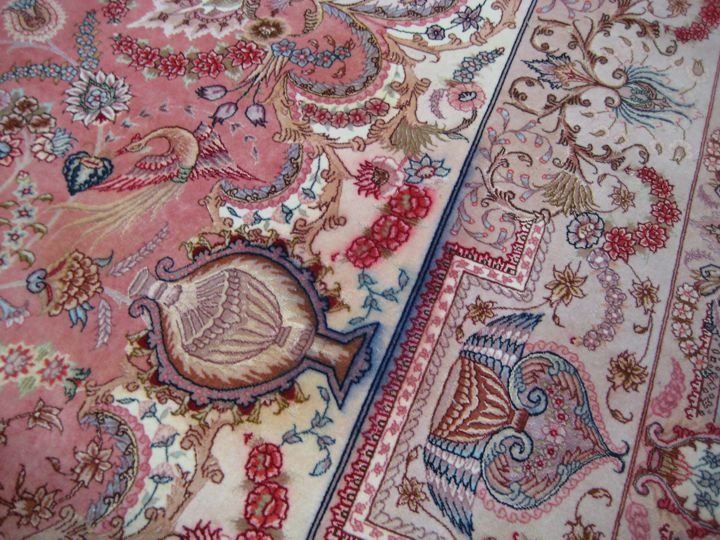
This silk and wool Tabriz rug has permanent fiber and dye damage from pet urine.
With woven rugs, the foundation fibers are typically cotton. This means the wool fibers are tied around cotton warps. So pet urine (or vomit or poo) will penetrate the wool fibers – because this accident is warm and acidic – and will become absorbed by the cotton interior fibers. This means the accident you see is only the tip of the accident iceberg.
This video shows what the damage looks like, and some suggestions to protect your rugs:
With all rugs, whatever you see from the surface will be larger problem in the center of the rug. And if you are trying to clean the area, and still have strong odor, this is because you cannot reach where the problem is without full immersion decontamination cleaning.
Ideally, when you notice an accident has happened – you jump to action. If your rug had fiber protector applied when it was newly purchased, this does not bulletproof your rug, but it does help prevent permanent staining and helps suspend the spill a bit longer so you have a chance of successful clean up. If the stain sits for too long, professional cleaning will be needed, but protected wool and silk rugs will wash up better than unprotected.
ATTENTION: If your rug is NOT real silk, but is artificial silk (Viscose, Rayon, Bamboo Silk, Banana Silk, Art Silk, Manmade Silk, or Tencel) – these are regenerated cellulose fibers. Wood pulp and cellulose by-products heavily chemically processed to create a soft shiny fiber.
These artificial silk fibers are essentially PAPER, so all wet spills are potentially a disaster for these rugs. Seek out specific care instructions from the rug maker, as most accident scenarios with these fibers will likely lead to the rug needing to be replaced. Even a plain water spill on a paper fiber can be a disaster.
These are your spills steps for wool:
1) If there is anything to scoop up – scoop it up. Blot up what you can with a cotton white towel.
2) Pour some soda water (or if you have no soda water – a mixture of one part white vinegar and three parts cool filtered water) into a container. Soak a light colored sponge (not the blue ones – they can bleed), wring out the excess, and DAMPEN the affected area. Then blot with a cotton towel to pull out the urine or vomit or fecal matter. Scrubbing can damage some lower quality wool, so blotting helps prevent any pile distortion or damage.
3) Blot until you see nothing much moving into the towel, and the area remains slightly damp. Then take a folded cotton towel and place one under and one over the area. Place weight over that spot to PRESS down the towel into the damp rug area. The towel under the area protects the floor, the towel on the top is meant to receive the moisture.
The weight will help create capillary action where the moisture in the rug fibers will move UP into the dry white cotton towels, and help move any contaminants along with that moisture. Any “loose” dye will also move up into the towel instead of outward into other areas of the rug.
Ideally have the weighted towel in place undisturbed for at least overnight. If there is no movement, then the wicking will be more successful. I use a kettlebell for that weight, because it will not move unless I move it. You can use a tray and stack books on it, or anything else with 5 or more pounds of weight that can stay in place overnight.
WARNING: If you see the rug dyes moving into the towel at any time when you are initially blotting the area, then you need to STOP, and you need to dry the area as soon as possible. You can pack the area with CORN STARCH, which will help absorb the moisture. This gets to be messy, but if you can pack the area with powder and get the rug to a professional rug cleaner, the damage can be minimized. (If your rug is real silk, you will want to quickly blot after the spill and then pack the area with CORN STARCH because most silk rug dyes will bleed relatively quickly, so better safe than sorry.)
With all rugs, you do NOT want to get the back side wet. This means you are putting too much moisture into the rug foundation, which can lead to mildew and eventually dry rot.
The biggest damage to rugs comes when you allow repeated pet accidents on rugs. The stains become permanent, the odor strong, and long term exposure creates both fungal (mildew) and bacterial contamination in the middle of the rug, which is not healthy for anyone’s indoor living space.
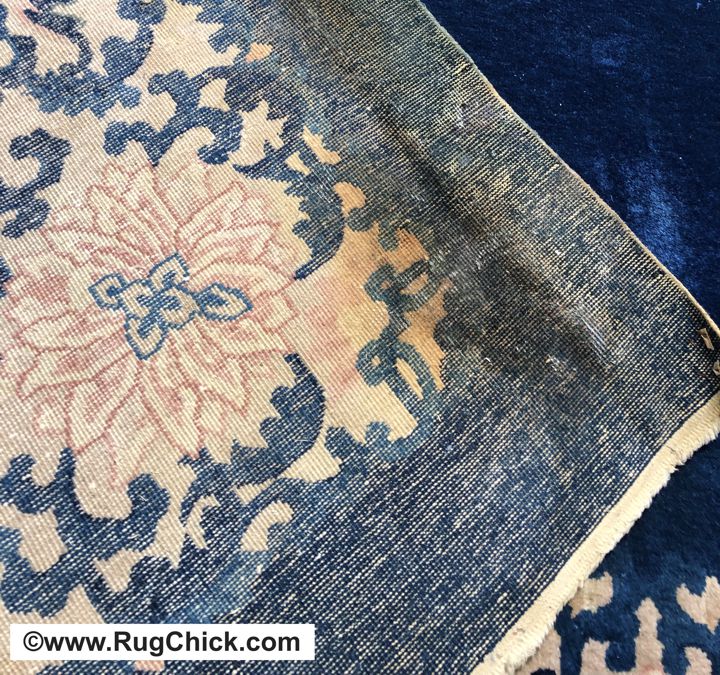
Peking Chinese rug with heavy cat damage which has led to mold all along the back side.
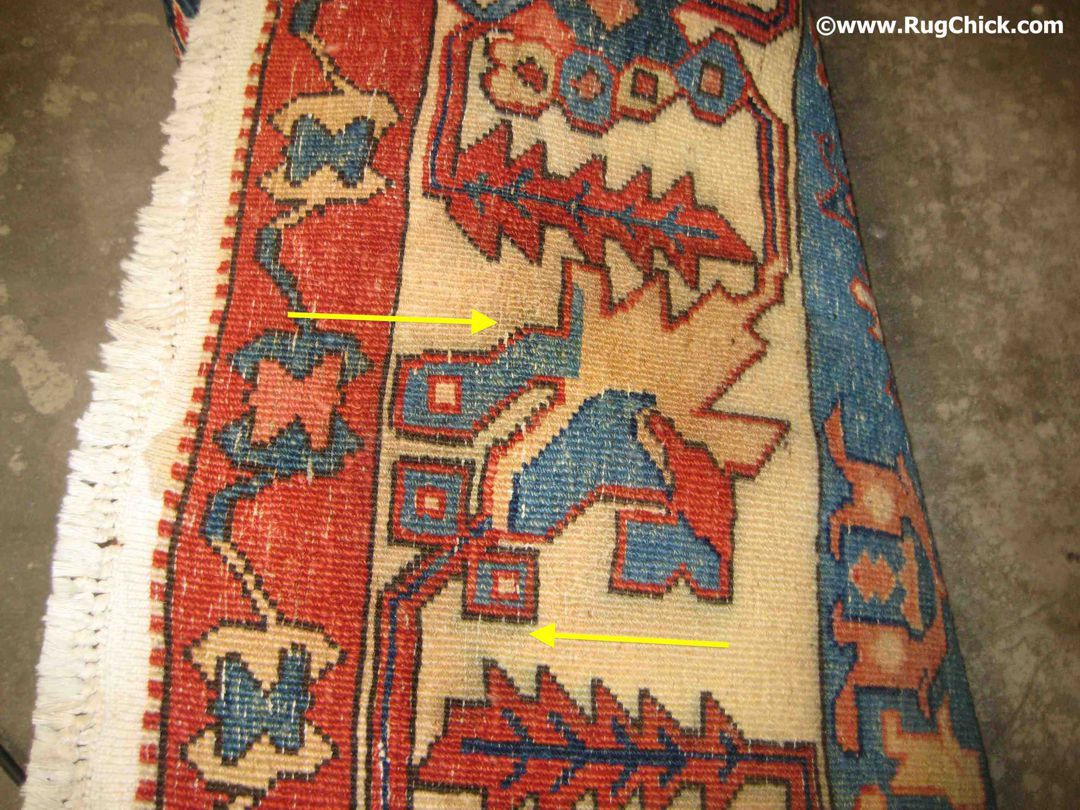
Turkish rug where the pet urine has led to mildew and dye bleed visible from the back side. Repeat pet urine causes permanent damage to fibers and dyes.
The only way to remove the urine from the inside of these rugs is to have them completely immersed in a facility specializing in washing rugs. The rug needs a thorough bath and decontamination process.
Cleaning rugs like these in the home only surface cleans them. It gets the top fibers cleaner, but does nothing to the inside fiber contamination. This is why they can still emit a strong odor even after being cleaned in the home. The process is NOT removing the source of the contamination, which is in the middle of the rug.
You can only reach the source of the problem with full washing.
If upcoming visitors or travel plans might make your pets a little nervous around the house, you might buy some inexpensive synthetic rugs to cover up your more valuable rugs, or to swap them out to remove the risk during those times.
If you have any questions about your rugs and getting them properly cleaned, feel free to send me a note using the CONTACT form.
Hope the spill tips help!
– Lisa

